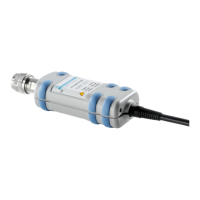R&S NRP-Z11/21/31/41/61/211/221 Remote Control - Commands
1137.7470.12 6.19 E-7
The query yields the averaging factor used in the sensor for the Trace mode.
Default setting: 4
SENSe:TRACe:AVERage:STATe[?] OFF | ON
SENSe:TRACe:AVERage:STATe switches the averaging filter on or off for the Trace mode.
The query yields
• 1 for OFF,
• 2 for ON.
Default setting: ON
SENSe:TRACe:AVERage:TCONtrol[?] MOVing | REPeat
SENSe:TRACe:AVERage:TCONtrol (terminal control) defines how the measurement results are to be
output in the Trace mode if the averaging filter has been activated.
The REPeat parameter specifies that a measurement result is not output until the entire measurement
has been completed. This means that the number of measurement cycle repetitions is equal to the set
averaging factor. If the averaging factor is large, the measurement time can be very long.
When settings are made with the MOVing parameter, intermediate values are output to facilitate early
detection of changes in the measured quantity. In the settled state – i.e. the number of measurements
specified by the averaging factor have been performed – a moving average is output in the Trace
mode. The SYStem:RUTime command can be used to vary the output rate over a wide range so that
some intermediate results can be ignored.
The query yields
• 1 for MOVing,
• 2 for REPeat.
Default setting: REPeat
SENSe:TRACe:MPWidth?
With SENSe:TRACe:MPWidth?, the attainable time resolution can be read out for the Trace mode. The
readout value is the smallest possible distance between two pixels – in other words, it is the smallest
time interval that can be assigned to a pixel. With internal triggering (setting TRIGger:SOURce
INTernal), this value is 10 Ss and is thus nearly identical with the reciprocal of the sampling frequency.
With external triggering (setting TRIGger:SOURce EXTernal), the value can be reduced down to 2.5 Ss.
However, the prerequisite for this is that realtime processing is deactivated (setting
SENSe:TRACe:REALtime OFF) so that more than one sampling sequence can be recorded. By
offsetting the sampling sequences to each other by a certain time (equivalent time sampling), the
sensor can then attain a better time resolution. The number of repetitions the sensor needs for this is
equal to 32 times the averaging factor.
If the user sets a point matrix that is denser than the resolution it corresponds to (10 Ss or 2.5 Ss), a
value is output for each of these points, but neighboring points may be assigned the same value.
Note: The point matrix to be output is defined by the trace length (setting SENSe:TRACE:TIME) and the
number of points (setting SENSe:TRACe:POINts).

